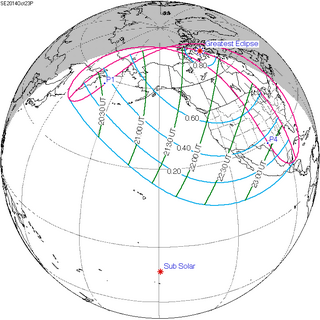Solar eclipse of October 23, 2014
| Solar eclipse of October 23, 2014 | |
|---|---|
| Type of eclipse | |
| Nature | Partial |
| Gamma | 1.0908 |
| Magnitude | 0.8114 |
| Maximum eclipse | |
| Coordinates | 71°12′N 97°12′W / 71.2°N 97.2°W |
| Times (UTC) | |
| (P1) Partial begin | 19:37:30 |
| Greatest eclipse | 21:45:39 |
| (P4) Partial end | 23:51:36 |
| References | |
| Saros | 153 (9 of 70) |
| Catalog # (SE5000) | 9540 |
A partial solar eclipse occurred on October 23, 2014. A solar eclipse occurs when the Moon passes between Earth and the Sun, thereby totally or partly obscuring the image of the Sun for a viewer on Earth. A partial solar eclipse occurs in the polar regions of the Earth when the center of the Moon's shadow misses the Earth.
The center of the Moon's shadow missed the Earth, passing above the North Pole, but a partial eclipse was visible at sunrise (October 24 local time) in far eastern Russia and Japan, and before sunset (October 23) across most of North America.
The partial eclipse was visible in most of North America.
Simulated greatest partiality from Nunavut, Canada at sunset
Partial solar eclipse October 23, 2014 at 21:25:57 UTC from San Jose, California.
Minneapolis, Minnesota, 21:34 UTC. The eclipse coincided with giant sunspot region 2192, the largest seen in 24 years.
Minneapolis, Minnesota, 22:35:23 UTC, wide angle, 30 minutes before sunset
Minneapolis, Minnesota, 22:36 UTC, greatest eclipse
Minneapolis, Minnesota, 22:54:12 UTC, 11 minutes before sunset
Partial solar eclipse, Coralville, Iowa, 22:55:58 UTC
Minneapolis, Minnesota, time lapse images
Each member in a semester series of solar eclipses repeats approximately every 177 days and 4 hours (a semester) at alternating nodes of the Moon's orbit. Note: Partial solar eclipses on January 4, 2011, and July 1, 2011, occur in the previous semester series.
The metonic series repeats eclipses every 19 years (6939.69 days), lasting about 5 cycles. Eclipses occur in nearly the same calendar date. In addition the octon subseries repeats 1/5 of that or every 3.8 years (1387.94 days).
...
Wikipedia

